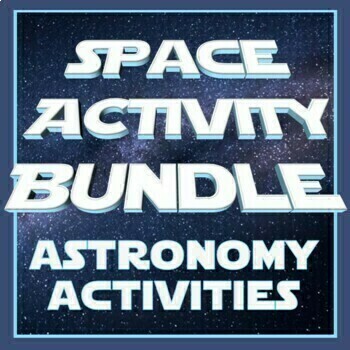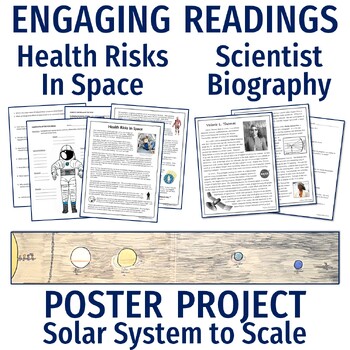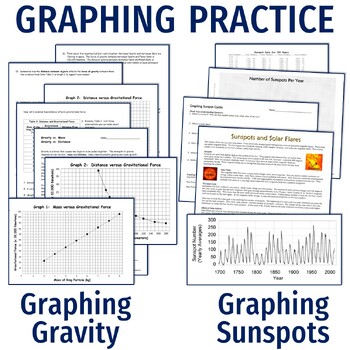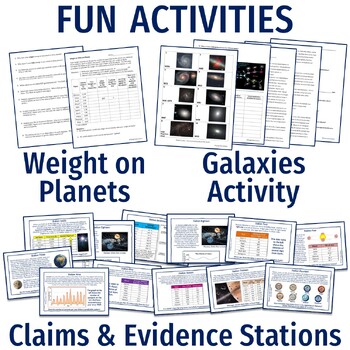Space and Astronomy Activity BUNDLE NGSS MS-ESS1
- Zip
- Easel Activity

What educators are saying
Products in this Bundle (8)
showing 1-5 of 8 products
Bonus
Also included in
- Never search for "something to do tomorrow" ever again! This bundle contains PRINT AND GO lessons, NO PREP activities, LOW PREP labs, and ENGAGING articles to supplement and thoroughly enhance an Earth and space science course. Every included resource is easy to implement, standards-based, and high-Price $399.99Original Price $639.06Save $239.07
Description
Save more than 35% off list prices! Includes 10 high-interest activities on the universe, sun, gravity, solar system, galaxies, and astronauts. These space lessons are designed to add FUN and RIGOR to an existing astronomy unit!
BUNDLE INCLUDES the Following:
- Galaxy Types Classification Activity (with Google option)
- Draw Our Solar System TO SCALE Poster Project
- Graphing Gravity Activity (with Google option)
- Weight on Different Planets Activity (with Google option)
- Group Activity: Graphing Sunspots and the Solar Cycle
- Health Risks in Space Reading & Activity (with Google option)
- NASA Scientist Biography & Questions (with Google option)
- Formation of the Universe Reading & Questions (with Google option)
- Formation of the Solar System Reading & Questions (with Google option)
- Telescope Build Project - FREE BONUS
INDIVIDUAL PDF RESOURCE DESCRIPTIONS:
Galaxy Types Sorting Activity: In this activity, students will:
- Read about different types of galaxies.
- Answer several text-dependent analysis questions.
- Practice classifying pictures of 10 real galaxies.
Draw Our Solar System TO SCALE: Students create a (really long!) poster of our solar system. In this activity, students will follow these steps:
- Tape several pieces of copy paper together to create a long poster.
- Follow specific, given measurements to create planets that are the correct diameter and distance apart.
- Color the planets according to the provided information.
- Label all space objects.
Graphing Gravity Activity: This gravity activity has students investigate the particles of Saturn's rings to determine the relationship between mass and gravity, and distance and gravity. There are several parts:
- Part 1: Introduction
- Part 2: Provides a data table of ring particles' masses and gravitational forces. Students analyze the data table for trends and then graph the data on a provided graph.
- Part 3: Provides a data table of ring particles' distances from Saturn and gravitational force. Analyze the data for trends and then graph the data on a provided graph.
- Part 4: Several analysis questions, including a claims/evidence/reasoning table, all of which focus on the relationship between mass and gravity, and distance and gravity.
Weight on Different Planets Activity: Give middle school students a better understanding of their relative weight on different planets as they have fun finding out how heavy or how light they would be elsewhere in the solar system!
Group Activity: Graphing Sunspots and the Solar Cycle: Students learn about and graph solar activity by year to discover the 11-year solar cycle. In this activity, students will:
- READ an introduction to sunspots and solar flares.
- ANSWER "check for understanding" questions.
- GRAPH sunspot data to reveal the 11-year solar activity cycle.
Health Risks in Space Reading & Activity: In this activity, students will:
- READ the engaging article "Health Risks" about the various effects of space on the body.
- Define KEY TERMS from the text.
- Summarize the effects of space on the body on a GRAPHIC ORGANIZER.
- ANSWER 10 text-dependent analysis questions.
NASA Scientist Biography & Questions: Valerie Thomas was a highly successful NASA scientist during a time that females, particularly Black women, were shunned by the scientific community. In this activity, students will:
- READ a 2-page article about the life and scientific accomplishments of Valerie Thomas.
- ANSWER 10 text-dependent reading comprehension questions related to Thomas' scientific work.
Formation of the Universe Reading & Questions: Read and answer questions about the Big Bang theory and the early universe.
Formation of the Solar System Reading & Questions: Read and answer questions about the formation of the solar system and planets.
Telescope Build Project - FREE BONUS: Fun hands-on astronomy extension project - a student favorite! This telescope project gives students detailed instructions on how to build a telescope using EASY SUPPLIES. Classes test their telescopes by attempting to view a playing card from a distance of 75 feet.
Teacher Notes:
- Answer keys included.
- Please note: these PDF documents are not editable.
- Standards: NGSS MS-ESS1-1, MS-ESS1-2, and MS-ESS1-3.
- Find more astronomy resources in the ASTRONOMY SECTION OF OUR STORE!
⭐⭐⭐ Click here to get 5 FREE EARTH & SPACE SCIENCE lessons! ⭐⭐⭐






